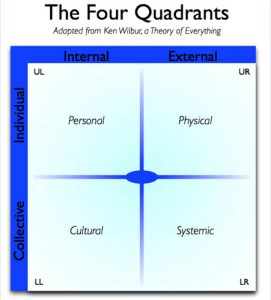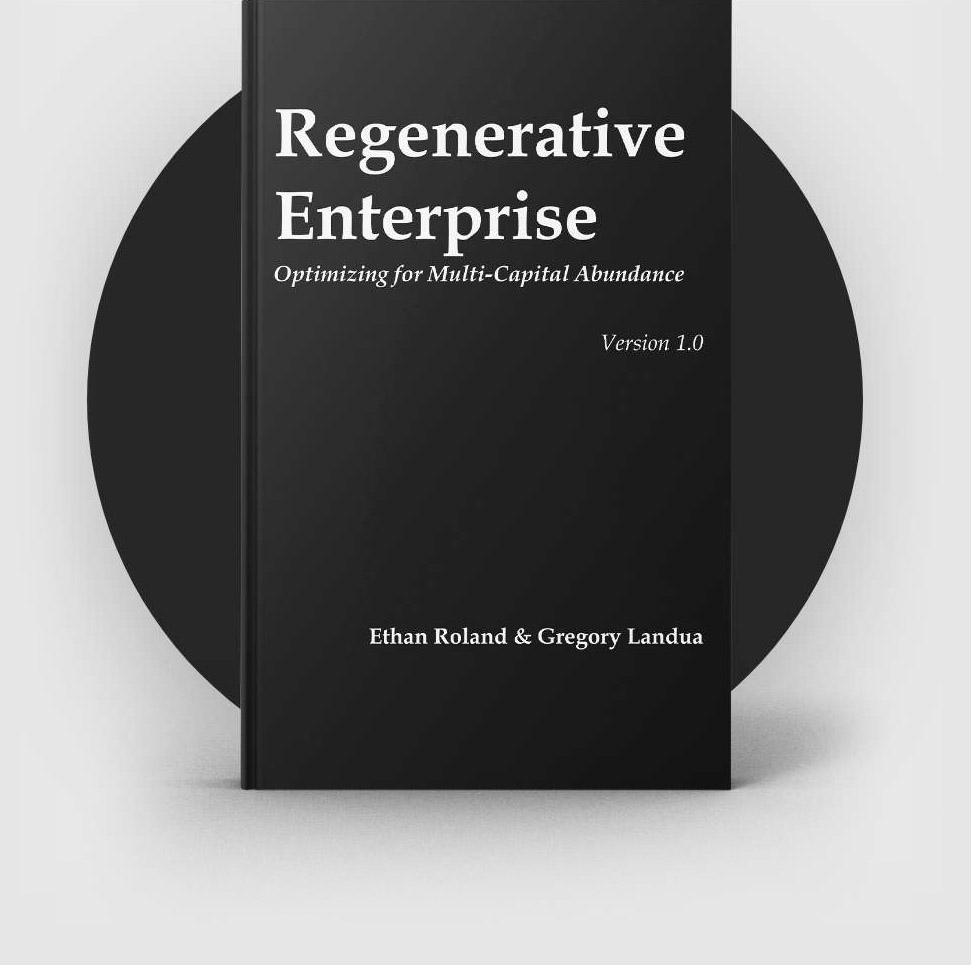External & Internal Development
So far, we have concentrated primarily on the external manifestations of degenerative, sustainable and regenerative systems. Underlying the eight forms of capital is another map, developed and utilized by philosopher Ken Wilbur and the international Integral community. The most basic level of the Integral framework is called the four quadrants:30
Figure 5.1 – The four quadrants. Each quadrant represents a facet of reality, and none of them can be reduced to any other. They all exist in all enterprises, whether they are acknowledged or not.
The quadrants are created by juxtaposing the internal facets of reality (on the left) with the external facets of reality (on the right), and the individual experiences of reality (on the top) with the collective experiences of reality (on the bottom). The quadrants are named:
- Upper Left: internal / individual
- Upper Right: external / individual
- Lower Left: internal / collective
- Lower Right: external / collective
The vast majority of entrepreneurial thinking and sustainability initiatives is focused on external results.31 Financial capital profits for executives, employees and stockholders is the simple bottom line for all current enterprises. Most triple-bottom-line companies add two other factors:
- Environmental ‘do-no-harm-ism’, focused on external metrics like air quality, water quality, less-toxic materials, or reduced amounts of waste sent to landfills.
- Social equity, usually translated again to external metrics like living wages, support for community organizations, or healthy working environments.
The Social Entrepreneurship community creates business and organizations that focus on finding “innovative solutions to society’s most pressing social problems”.32 However, these entrepreneurs are also required to produce external financial capital profits, external social systems benefits, and external environmental benefits to prove their effectiveness. All realms of the current business world are focused on only one half of reality. Something is missing.
A tenant of the four quadrants model is that no organization, venture, or individual can achieve its aims by working solely in the external quadrants. Especially if the purpose is to develop sustainability or regeneration of whole living systems, the internal quadrants must be fully integrated into the project. For example, consider a project run by a christian missionary organization that aims to increase urban food security by helping people plant gardens near their homes.
This project could focus on getting legal access to gardening spaces, providing soil and water and tools and seeds, hosting community classes on different aspects of gardening, promoting the benefits for physical health, or perhaps even exploring the money-saving or money-making potential of small-scale crop production. The project could do all of these external things, at the highest level of quality and with the best intentions, but still not achieve its goals. Why? Because the internal quadrants of the individuals and community have not been addressed.
The people in the urban area could have a firm internal belief that growing vegetables is a dirty, lowly, menial way to spend their time, suitable only for poor farmers in the countryside. Urban youth might think that growing food is ‘un-cool’, experience peer-pressure to not get involved, or feel fear about some aspect of the project. The population could be orthodox jews, whose shared cultural beliefs are fundamentally at odds with the christian missionary organization running the project. Or perhaps some people in the area have African-american or Caribbean heritage, and connect agricultural activity with the oppression and pain of their ancestors’ slavery.
Without exploring, understanding, and actively addressing the internal aspects of the people and communities involved in a project, wholeness cannot be achieved. Enterprises cannot succeed at regeneration without both the external and the internal.
Zooming out to a larger, societal scale, internal individual preferences and shared cultural beliefs often have their root in painful and oppressive historical events. Many of the original colonists of what is now called the United States were fleeing from religious persecution – they were Christian protestants who had been systematically mistreated for attempting to follow their own beliefs. This left deep psychological, emotional, and intellectual wounds on each individual. They fled to a “new” land where they could have freedom from oppression, and then immediately repeated the pattern by systematically mistreating, stealing from, and killing the native peoples of the continent, who were following their own beliefs.
In fact, this oppressive pattern of colonization goes back even further. In the country now called Great Britain, pre-”european” indigenous people were colonized and conquered by successive waves of Celts, Romans, and Germanic peoples.33 In each case, the older cultures and languages were dominated and mostly destroyed by the colonists. A similar story exists for almost all of the countries in modern-day
Europe, and the large-scale cultural wounds inflicted were never addressed or healed. During the so-called “discovery” period of the 15th and 16th centuries, these unhealed wounds of violence and colonization were carried onwards across the ocean – Europeans dominated and destroyed much of the cultural, spiritual, and living capital of what is now called North America.34
The oppressed became the oppressors. Culturally, this trend continues today.
Agriculturally, this trend also continues today. The fossil-fuel-driven shift towards large-scale industrial food monocultures impoverishes each of the places it touches and the people who live there. The degradation of ecosystem services and living capital is oppressive: Humans systematically mistreat the environment around them for material or financial capital gain.
Our belief is that most of the current global society is based on oppression: the systematic mistreatment of one group of people or form of capital by another group of people or by the society as a whole. The primary oppression is financial, wherein the few people that control the vast majority of financial capital actively (but usually unconsciously) destroy living capital and perpetuate artificial divisions between human beings based on their skin color, country of origin, gender, age, or other factors to achieve continued financial capital accumulation.
The financial inequality currently present in the world is held in place by racism, sexism, age-ism, and other oppressions that insidiously separate people from each other35 and prevent them from supporting each others happiness, health, and multi-capital wealth.
This system hurts every person on the planet. People who are targeted by oppression are systematically denied access to resources, verbally and physically insulted, and treated as inferior human beings. Sometimes the oppressive ideas and messages will become internalized by people who are targeted by oppression, and then acted out upon themselves and other people in the same targeted group. For example, many women in the current society receive the incorrect and oppressive message that they “are not smart” or should “keep quiet” from a young age. Some women come to believe this about themselves, and may act to invalidate or discourage other women who display their intelligence or voice their thinking. This is called ‘Internalized Oppression’, and is one of the major barriers to ending oppression in the world.36
People in oppressor roles are also hurt by oppression, through rigid feelings of guilt and blame, acts of self-deprecation and self-mistrust, and a pervasive isolation from people in the oppressed groups and even from each other. However, the hurts experienced by people in oppressor roles cannot be compared to the hurts experienced by people targeted by oppression.37 Each individual may contain a mix of oppressed and oppressor roles: A working-class man in the United States of Irish heritage may be oppressed as an immigrant and a person of the working class, but may also find himself in oppressor roles as a “white” person and as a man.
Each of us is a part of this system. The multiple forms of oppression keep people divided from each other, while living capital degrades and financial capital disparity increases around the globe.
Whether each individual likes it or not, each individual carries wounds, prejudices, and rigid ways of acting and thinking from growing up in this oppressive system. No individual would choose this system of inequality had they not been hurt and unconsciously trained into perpetuating it.
Ask yourself: Would I choose to design a world where 50% of the people will suffer malnutrition,38 48% cannot speak or act according to their faith and conscience due to harassment, imprisonment, torture, or death,39 and the collective actions of humans on our planet threaten 66% of all the world’s living species with extinction this century?40
Again: no individual consciously chose to systematically degrade the living, social, cultural, and spiritual capital of the world. And, it is not the fault of any person or any particular group of people. All people are inherently good, but as a resulted of being systematically mistreated (as young people, as women, as men, as darker-skinned people, as jews, as muslims, as christians, as indigenous people, as communists, as capitalists, etc.), people seek to release their wounds by systematically mistreating the earth’s living capital and the social, cultural, and spiritual capital of other peoples in order to achieve a false sense of safety and separation from the oppression they have undergone.
All oppression can be ended. Each individual who wants to create a equitable world free from oppression must first seek healing and liberation of their own wounds and prejudices. If each individual does not take on a path of personal development and healing, our societies will continue to re-create the patterns of oppression and extraction that have brought the world to its degraded state. If each individual does take on a path of personal development and healing, they will begin to transform their own reactive, patterned, oppressive ways of being into consciousness and action that can regenerate local human and natural and ecosystems.
There are many communities, schools, and modalities of personal development. Entrepreneurs engaged with them report the following results as they work to heal their internal landscape:
- Increased ability to articulate and achieve goals
- Improved capacity for clear communication
- Greater integrity in making and keeping commitments
- Enhanced intellectual and emotional flexibility, especially in difficult or ‘charged’ situations
- Decreased reactiveness, anger, and fighting in all realms of life
- Significantly less self-doubt and self-loathing
- Deeper understanding and compassion of different people and situations
- A greater sense of spiritual well-being and confidence
Additionally, regenerative internal development leads to positive external development: Clear-thinking, spiritually confident, emotionally resilient people are more effective at repairing the world’s living and cultural capital.
Each individual in a regenerative enterprise must commit to ongoing personal internal development. Ideally, the individuals develop an ecology of personal growth and healing modalities, ensuring continued emotional, intellectual, and spiritual development.
Excerpt from:
Regenerative Enterprise: Optimizing for Multi-Capital Abundance by Ethan C. Roland & Gregory Landua
30 Wilber, Ken. A Brief History of Everything. Boston: Shambhala Publications, 199+.
31 Brown, Barrett C. “ The Four Quadrants of Sustainability.” Integral Thinkers, 4 April 2011.
32 “What is a Social Entrepreneur?” Ashoka: Innovators for the Public. Ashoka, Inc. Web. Accessed 7 Dec. 2012.
33 “History of Great Britain.” Wikipedia, The Free Encyclopedia. Wikimedia
Foundation, Inc. Accessed 7 Dec. 2012.
34Nabokov, Peter (Ed.) Native American Testimony: A Chronicle of Indian-
White Relations from Prophecy to the Present, 1492-2000. New York:
Penguin Books, 1999.
35Collins, P.H. (2000). “Gender, Black Feminism, and Black Political
Economy.” Annals of the American Academy of Political and Social Science,
- 41–53.
36 “Oppression” Wikipedia, The Free Encyclopedia. Wikimedia Foundation,
Inc. Accessed 7 Dec. 2012.
37 Jackins, Tim. Working Together to End Racism: Healing from the Damage
Caused by Racism. United to End Racism, 2002.
38 “The Miniature Earth Official Version” The Miniature Earth Project.
Luccaco*be digital Ltd. Web. Accessed 15 Dec 2012
39 ibid
40“Life support services threatened, 700 experts urge more prominence
of biodiversity on world agenda” Diversitas International. 14 Nov. 2005.

